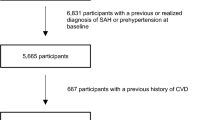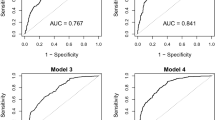Abstract
Objective:
Polynesians in New Caledonia have an increased risk for developing diabetes, compared to Melanesians or Europeans. They are also more prone to obesity. The aim of this study was to analyse differences in the pre-diabetic state that may explain the varying susceptibility to diabetes between these three ethnic groups, focusing on the balance between insulin resistance and capacity of pancreatic cells to secrete insulin.
Design and subjects:
The CALDIA Study is a population-based cross-sectional survey of diabetes prevalence conducted in New Caledonia. All participants who did not have diabetes, according to the results of a 0–2 h oral glucose tolerance test (n=392), were selected for analysis.
Results:
Compared to Europeans, Polynesians and Melanesians had significantly higher body mass indices (BMI) and waist-to-hip ratios (WHRs). Polynesians had higher fasting plasma glucose values than Europeans or Melanesians (6.03 mmol/l, vs 5.78 and 5.46, respectively; P<0.0001). Fasting plasma insulin level and the estimate of insulin resistance by homeostasis model assessment were not significantly different between the three ethnic groups. Homeostasis model assessment estimate of β-cell secretory capacity was lower in Polynesians compared to the two other ethnic groups (83.1 mU/mmol, vs 119.3 and 125.2, respectively; P<0.02).
Conclusion:
Despite a high prevalence of central obesity, as judged by high BMI and WHR, in Polynesians of New Caledonia, their high risk of diabetes may be more strongly related to a defect in insulin secretion capacity than to insulin resistance.
This is a preview of subscription content, access via your institution
Access options
Subscribe to this journal
Receive 12 print issues and online access
$259.00 per year
only $21.58 per issue
Buy this article
- Purchase on Springer Link
- Instant access to full article PDF
Prices may be subject to local taxes which are calculated during checkout

Similar content being viewed by others

References
Saad MF, Knowler WC, Pettitt DJ, Nelson RG, Charles MA, Bennett PH . A two-step model for development of non-insulin-dependent diabetes. Am J Med 1991; 90: 229–235.
Expert Committee. Report of the expert committee on the diagnosis and classification of diabetes mellitus. Diabetes Care 1997; 20: 1183–1197.
Zimmet PZ, McCarty DJ, de Courten MP . The global epidemiology of non-insulin-dependent diabetes mellitus and the metabolic syndrome. J Diabetes Complications 1997; 11: 60–68.
Abate N, Chandalia M . The impact of ethnicity on type 2 diabetes. J Diabetes Complications 2003; 17: 39–58.
Simmons D, Thompson CF, Volklander D . Polynesians: prone to obesity and Type 2 diabetes mellitus but not hyperinsulinaemia. Diabetes Med 2001; 18: 193–198.
Papoz L, Barny S, Simon D . Prevalence of diabetes mellitus in New Caledonia: ethnic and urban–rural differences. CALDIA Study Group. CALedonia DIAbetes Mellitus Study. Am J Epidemiol 1996; 143: 1018–1024.
Tassié JM, Papoz L, Barny S, Simon D . Nutritional status in adults in the pluri-ethnic population of New Caledonia. The CALDIA Study Group. Int J Obes Relat Metab Disord 1997; 21: 61–66.
World Health Organization. Report of a WHO consultation on obesity: preventing and managing the global epidemic. Geneva: WHO, 1998.
World Health Organization. Definition, diagnosis and classification of diabetes mellitus and its complications. Part 1: diagnosis and classification of diabetes mellitus. WHO: Geneva, 1999.
Matthews DR, Hosker JP, Rudenski AS, Naylor BA, Treacher DF, Turner RC . Homeostasis model assessment: insulin resistance and beta-cell function from fasting plasma glucose and insulin concentrations in man. Diabetologia 1985; 28: 412–419.
Shaw JA, Zimmet PZ, Decourten M, Dowse GK, Chitson P, Gareeboo H et al. Impaired fasting glucose or impaired glucose tolerance - What best predicts future diabetes in Mauritius? Diabetes Care 1999; 22: 399–402.
Lillioja S, Mott DM, Spraul M, Ferraro R, Foley JE, Ravussin E et al. Insulin resistance and insulin secretory dysfunction as precursors of non-insulin-dependent diabetes mellitus. Prospective studies of Pima Indians. N Engl J Med 1993; 329: 1988–1992.
Dowse GK . Incidence of NIDDM and the natural history of IGT in Pacific and Indian Ocean populations. Diabetes Res Clin Pract 1996; 34 (Suppl): S45–S50.
Haffner SM, Stern MP, Mitchell BD, Hazuda HP, Patterson JK . Incidence of type II diabetes in Mexican Americans predicted by fasting insulin and glucose levels, obesity, and body-fat distribution. Diabetes 1990; 39: 283–288.
Bonora E, Targher G, Alberiche M, Bonadonna RC, Saggiani F, Zenere MB et al. Homeostasis model assessment closely mirrors the glucose clamp technique in the assessment of insulin sensitivity: studies in subjects with various degrees of glucose tolerance and insulin sensitivity. Diabetes Care 2000; 23: 57–63.
Haffner SM, Miettinen H, Stern MP . The homeostasis model in the San Antonio Heart Study. Diabetes Care 1997; 20: 1087–1092.
Segal KR, Landt M, Klein S . Relationship between insulin sensitivity and plasma leptin concentration in lean and obese men. Diabetes 1996; 45: 988–991.
Ravussin E, Swinburn BA . Pathophysiology of obesity. Lancet 1992; 340: 404–408.
Ferrannini E, Balkau B . Insulin: in search of a syndrome. Diabetes Med 2002; 19: 724–729.
Nakagami T, Qiao Q, Carstensen B, Nhr Hansen C, Hu G, Tuomilehto J et al. Age, body mass index and Type 2 diabetes – associations modified by ethnicity. Diabetologia 2003; 46: 1063–1070.
Deurenberg P, Yap M, Van Staveren WA . Body mass index and percent body fat: a meta analysis among different ethnic groups. Int J Obes Relat Metab Disord 1998; 22: 1164–1171.
Swinburn BA, Ley SJ, Carmichael HE, Plank LD . Body size and composition in Polynesians. Int J Obes Relat Metab Disord 1999; 23: 1178–1183.
Gippini A, Mato A, Pazos R, Suarez B, Vila B, Gayoso P et al. Effect of long-term strength training on glucose metabolism. Implications for individual impact of high lean mass and high fat mass on relationship between BMI and insulin sensitivity. J Endocrinol Invest 2002; 25: 520–525.
Velho G, Froguel P . Genetic, metabolic and clinical characteristics of maturity onset diabetes of the young. Eur J Endocrinol 1998; 138: 233–239.
Zimmet P . Antibodies to glutamic acid decarboxylase in the prediction of insulin dependency. Diabetes Res Clin Pract 1996; 34 (Suppl): S125–S131.
Acknowledgements
We thank each member of the CALDIA Study Group who permitted the design and/or conduction of the CALDIA Study. Coordination, INSERM - in France: L Papoz (principal coordinator), D Simon, J Cubeau, A Lacroux, A Forhan and A Ponton; in New Caledonia: S Barny (local coordinator), D Juranville, H Lmahdi and R Manuohalalo. Health and Social Services in New Caledonia - Medical and Research Commission: F Ledoux and C Merger; Territory: M Germain; North Province: P Calen and P Genty; Loyalty Islands: J Coscoquela and P Buffet; South Province: JG Lambert and P Baqué; and Biochemistry (Territorial Hospital): S Solar and Y Barguil.
We thank V Wirquin of the Henri Mondor Hospital Laboratory (Créteil, France) for the measures of fasting plasma insulin.
This research was financed by Grant 492015 from the INSERM (Institut National de la Santé et de la Recherche Médicale), Grant 607006 from the French Ministry of Cooperation, with additional support from the Medical Commission and the Provinces of New Caledonia, the Rotary and Lions Clubs of Noumea, and Behring Diagnostic Laboratory.
Author information
Authors and Affiliations
Consortia
Corresponding author
Rights and permissions
About this article
Cite this article
Defay, R., Jaussent, I., Lacroux, A. et al. Relationships between glycaemic abnormalities, obesity and insulin resistance in nondiabetic Polynesians of New Caledonia. Int J Obes 31, 109–113 (2007). https://doi.org/10.1038/sj.ijo.0803384
Received:
Revised:
Accepted:
Published:
Issue Date:
DOI: https://doi.org/10.1038/sj.ijo.0803384


